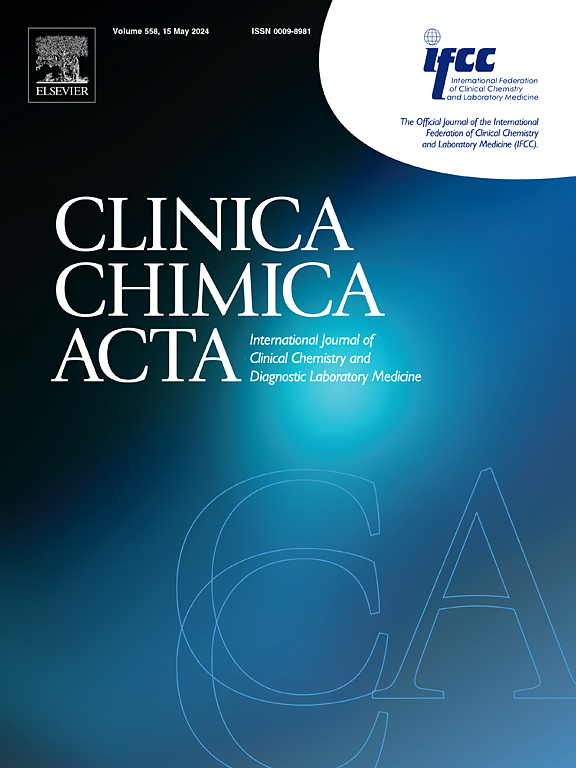小儿重症肺炎的病原体分布和感染模式:有针对性的新一代测序研究。
IF 3.2
3区 医学
Q2 MEDICAL LABORATORY TECHNOLOGY
引用次数: 0
摘要
目的:儿童重症肺炎发病率高、死亡率高,是一项重大的临床挑战。本研究旨在评估儿童重症肺炎患者的病原体分布和感染模式:本研究纳入了2021年7月至2023年11月期间广西妇幼保健院收治的110名确诊为重症肺炎的儿科患者。采用病原体靶向新一代测序技术(tNGS)鉴定这些病例中的呼吸道病原体:结果:110 例病例中有 109 例检测到病原体,阳性检测率为 99.09%。在这些病例中,25 例(22.72%)为单一病原体感染,84 例(76.36%)为混合感染。重症肺炎患儿的感染模式以细菌和病毒混合感染较为常见(28.2%,31/110)。110 名重症肺炎患儿共鉴定出 39 种病原体,排在前三位的病原体分别是肺炎支原体(30.91%,34/110)、人类呼吸道合胞病毒 A 型(26.36%,29/110)和人类疱疹病毒(18.18%,20/110)。值得注意的是,38.2%(13/34)的病例发现了耐大环内酯类药物的肺炎支原体(MRMP)。此外,40%(44/110)的患儿需要入住重症监护室(ICU):结论:tNGS 的应用在儿科重症肺炎患者的病原体检测中发挥了重要作用。本研究发现的主要病原体是肺炎支原体、人类呼吸道合胞病毒和人类疱疹病毒。此外,在 76.36% 的病例中发现了涉及多种病原体的混合感染,其中相当一部分(40%)患者需要接受重症监护。本文章由计算机程序翻译,如有差异,请以英文原文为准。
Pathogen distribution and infection patterns in pediatric severe pneumonia: A targeted next-generation sequencing study
Objective
Severe pneumonia in children represents a significant clinical challenge due to its high incidence and associated mortality. This study aimed to assess the distribution of pathogens and patterns of infection in pediatric patients with severe pneumonia.
Methods
This study included 110 pediatric patients diagnosed with severe pneumonia, who were admitted to Guangxi Maternal and Child Health Hospital between July 2021 and November 2023. Pathogen-targeted next-generation sequencing (tNGS) was employed to identify respiratory pathogens in these cases.
Results
Pathogens were detected in 109 out of 110 cases, yielding a positive detection rate of 99.09%. Among these cases, 25 (22.72%) involved single-pathogen infections, while 84 (76.36%) were characterized by mixed infections. The infection pattern in children with severe pneumonia was relatively common with bacterial-viral coinfection (28.2%, 31/110). A total of 39 pathogens were identified from the 110 children with severe pneumonia, with the top three pathogens being Mycoplasma pneumoniae (30.91%, 34/110), Human Respiratory Syncytial Virus Type A (26.36%, 29/110), and Human Herpesvirus (18.18%, 20/110). Notably, 38.2% (13/34) of the cases were found to have macrolide-resistant Mycoplasma pneumoniae (MRMP). Additionally, 40% (44/110) of the children required admission to the intensive care unit (ICU).
Conclusion
The application of tNGS demonstrates significant utility in the detection of pathogens in pediatric patients with severe pneumonia. The predominant pathogens identified in this study are Mycoplasma pneumoniae, Human Respiratory Syncytial Virus, and Human Herpesvirus. Furthermore, mixed infections involving multiple pathogens were observed in 76.36% of the cases, and a substantial proportion (40%) of these patients necessitated intensive care.
求助全文
通过发布文献求助,成功后即可免费获取论文全文。
去求助
来源期刊

Clinica Chimica Acta
医学-医学实验技术
CiteScore
10.10
自引率
2.00%
发文量
1268
审稿时长
23 days
期刊介绍:
The Official Journal of the International Federation of Clinical Chemistry and Laboratory Medicine (IFCC)
Clinica Chimica Acta is a high-quality journal which publishes original Research Communications in the field of clinical chemistry and laboratory medicine, defined as the diagnostic application of chemistry, biochemistry, immunochemistry, biochemical aspects of hematology, toxicology, and molecular biology to the study of human disease in body fluids and cells.
The objective of the journal is to publish novel information leading to a better understanding of biological mechanisms of human diseases, their prevention, diagnosis, and patient management. Reports of an applied clinical character are also welcome. Papers concerned with normal metabolic processes or with constituents of normal cells or body fluids, such as reports of experimental or clinical studies in animals, are only considered when they are clearly and directly relevant to human disease. Evaluation of commercial products have a low priority for publication, unless they are novel or represent a technological breakthrough. Studies dealing with effects of drugs and natural products and studies dealing with the redox status in various diseases are not within the journal''s scope. Development and evaluation of novel analytical methodologies where applicable to diagnostic clinical chemistry and laboratory medicine, including point-of-care testing, and topics on laboratory management and informatics will also be considered. Studies focused on emerging diagnostic technologies and (big) data analysis procedures including digitalization, mobile Health, and artificial Intelligence applied to Laboratory Medicine are also of interest.
 求助内容:
求助内容: 应助结果提醒方式:
应助结果提醒方式:


